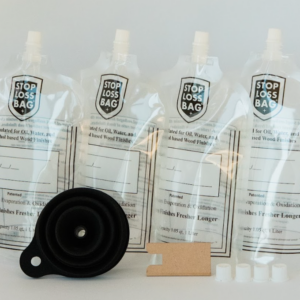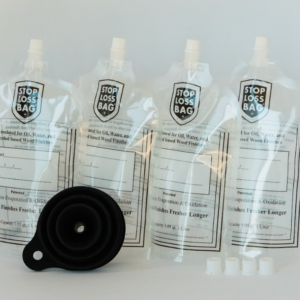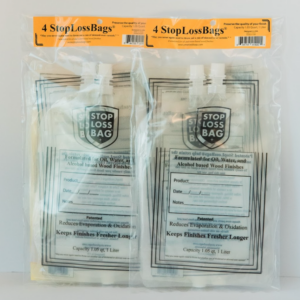How to Use
StopLossBags® are easy to use, economical and most importantly keep your finishes fresh.
Filling Your StopLossBag®
To fill using the Filler & Adapter Tube Set, begin by fitting the dark grey filler tube over the end of the bag’s spout. It’s a snug fit and allows you to attach a small funnel. For a larger funnel fit the flexible red adapter tube over the grey filler tube.
Our specially formulated StopLossBags® Collapsible Funnel allows easy one-step transfer from a quart or liter can to a StopLossBag®. It stretches over the top of the can while the small end fits the StopLossBag®. It is important to blow air into the bag before attaching the funnel. This allows the full transfer of finish.
The funnel is simple to clean. Place it upside down on a folded paper towel overnight. The dried finish peels easily from the inside. Note that, thin oil finishes may need to be cleaned with solvents.
Tips and Tricks
for Getting the Best Results with your StopLossBags®
- Write the type of liquid and the date on the bag with a Felt Tipped Pen (Magic Marker®). Felt Tipped Pen’s wipe away easily with alcohol.
- You can fill the StopLossBags via the funnel, or a turkey baster!
- Blow into the pouch to open it up before filling it.
- Dispense the liquid from the bag into a wide container (called a cut pot or a cut bucket). We recommend using a 24 oz plastic storage container.
- To extend the life of the filler & adapter tubes, remove them from the funnel so the flexible plastic can relax during storage.
- A light coating of wax on the threads of the cap makes it easier to remove.
- If a bubble of air is left in the neck, some oxidation can occur. This can lead to a ring of partially gelled liquid forming in the spout. To prevent this, lay the bag on its side so the bubble comes to rest in the center of the bag.
- If you suspect or see evidence of jelling, use a strainer to remove the gelled liquid.
- When you use the last of the liquid in a bag, flush the bag immediately with solvent. This will prevent the remaining liquid from oxidizing.
- Semi-gloss, satin, and matte finishes should be stirred well in the can before transferring to the StopLossBags® pouch. As the bag sits, the matting agents will begin to settle in the lower part of the bag. To correct this, squeeze the bag, invert it, and rotate it.
- If you are using the funnel for alcohol-based finishes, be sure to clean it with alcohol immediately after use.
- If your finish is light-sensitive, keep it stored in a dark place.
- If you and a group of friends order multiple StopLossBags® you may find it beneficial to go together and save on shipping costs or to purchase finishes by the gallon and share them.
Our One Year Side-by-Side Test Results
(StopLossBags® vs. Original Cans)
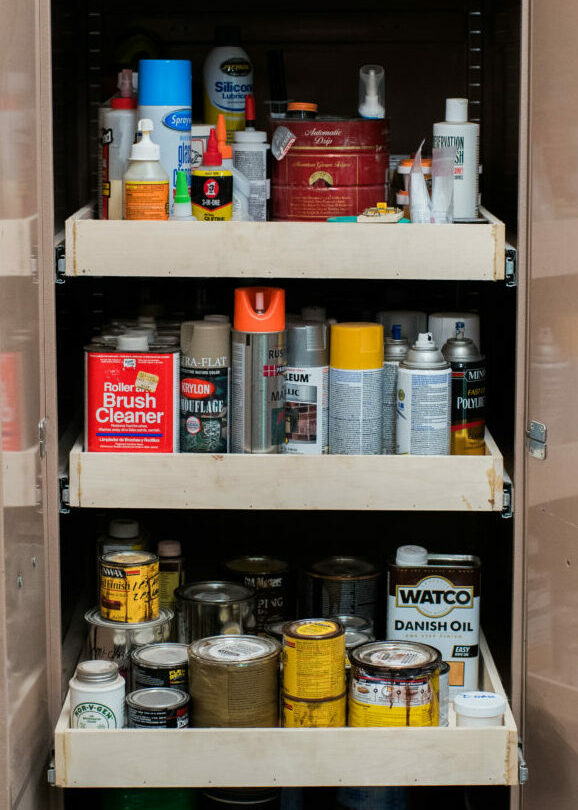
Does this look familiar?
In July 2014, we started a long-term experiment to test how well oil-based wood finishes hold up when stored in StopLossBags®. We filled the bags with the finishes, weighed them using a precise scale, and regularly checked their weight on the same scale. After one year, here are the results:
Salad Bowl Finish:
- We transferred most of a can of popular salad bowl finish (about 4/5 of the can) into a StopLossBag® and left the rest in the can.
- We sealed the can and squeezed out any air from the bag before closing it.
- We weighed the finish in the bag but did not weigh the remaining finish in the can.
- On July 31, 2014, the weight of the Salad Bowl Finish was 387.5 grams.
- One year later, on July 31, 2015, it weighed 387.0 grams, a loss of 0.5 grams, or 99.87% of its original weight.
- The finish left in the original can became unusable after 46 days.
Polyurethane:
- Similarly, we transferred most of a quart can of popular gloss polyurethane (about 4/5 of the can) into a StopLossBag® and left the rest in the can.
- We sealed the can and squeezed out any air from the bag before closing it.
- We weighed the finish in the bag but did not weigh the remaining finish in the can.
- On July 31, 2014, the weight of the Poly was 709.9 grams.
- One year later, on July 31, 2015, it weighed 709.6 grams, a loss of 0.3 grams, or 99.958% of its original weight.
- The finish left in the original can became unusable after 54 days.
We believe that using StopLossBags® pouches for storage can help woodworkers preserve the quality of their finishes for a much longer time.
Just for fun we extended the test for two full years. Here are the results:
Salad Bowl Finish: Weight: 385.8 grams, which is 99.77% of the original weight.
Danish Finish: Weight: 671.3 grams, which is 99.90% of the original weight.
Polyurethane: Weight: 708.7 grams, which is 99.73% of the original weight.
All three finishes appeared to maintain their original composition well, although some slight color changes were observed.
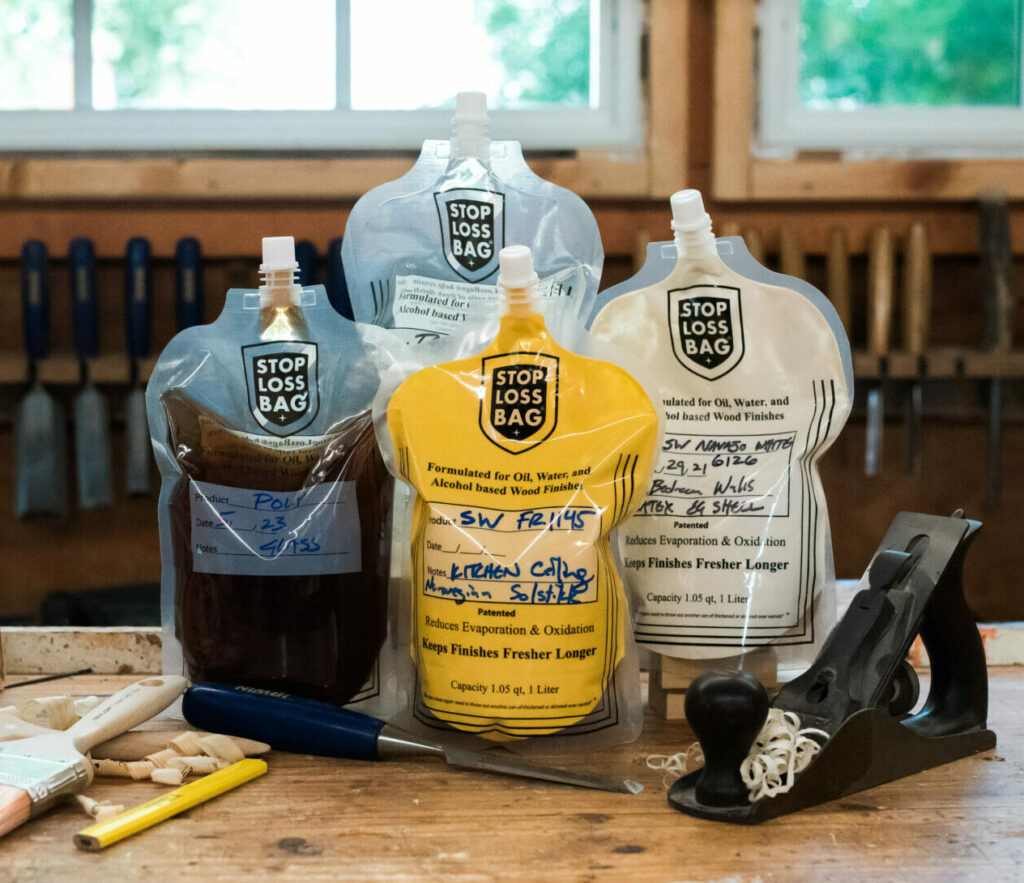
We wish you well on your finishing projects!
Our One Year Side-by-Side Test Results
(StopLossBags® vs. Original Cans)
In July 2014, we started a long-term experiment to test how well oil-based wood finishes hold up when stored in StopLossBags®. We filled the bags with the finishes, weighed them using a precise scale, and regularly checked their weight on the same scale. After one year, here are the results:
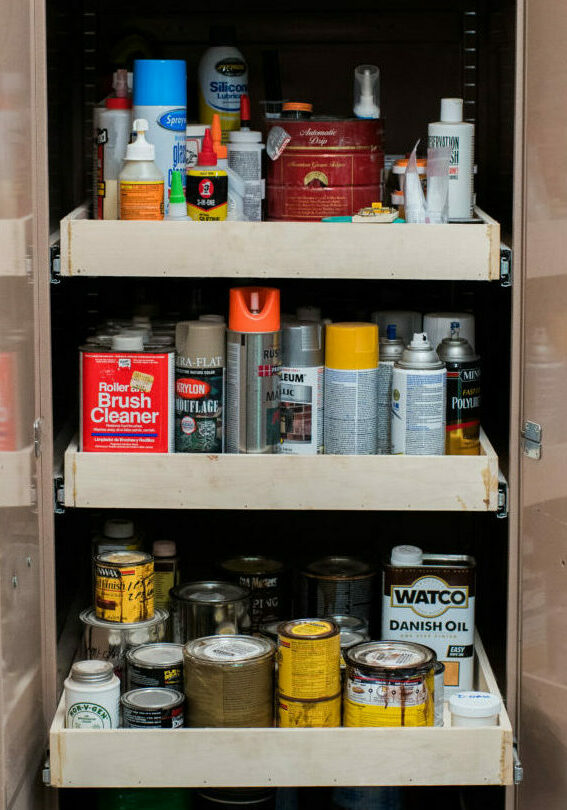
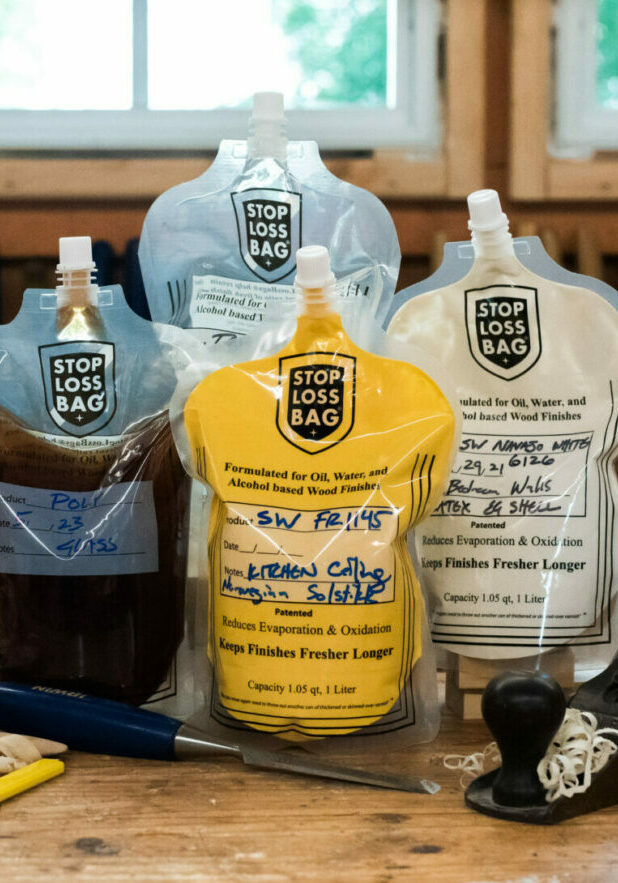
Salad Bowl Finish:
- We transferred most of a can of popular salad bowl finish (about 4/5 of the can) into a StopLossBag® and left the rest in the can.
- We sealed the can and squeezed out any air from the bag before closing it.
- We weighed the finish in the bag but did not weigh the remaining finish in the can.
- On July 31, 2014, the weight of the Salad Bowl Finish was 387.5 grams.
- One year later, on July 31, 2015, it weighed 387.0 grams, a loss of 0.5 grams, or 99.87% of its original weight.
- The finish left in the original can became unusable after 46 days.
Polyurethane:
- Similarly, we transferred most of a quart can of popular gloss polyurethane (about 4/5 of the can) into a StopLossBag® and left the rest in the can.
- We sealed the can and squeezed out any air from the bag before closing it.
- We weighed the finish in the bag but did not weigh the remaining finish in the can.
- On July 31, 2014, the weight of the Poly was 709.9 grams.
- One year later, on July 31, 2015, it weighed 709.6 grams, a loss of 0.3 grams, or 99.958% of its original weight.
- The finish left in the original can became unusable after 54 days.
We believe that using StopLossBags® pouches for storage can help woodworkers preserve the quality of their finishes for a much longer time.
Just for fun we extended the test for two full years. Here are the results:
Salad Bowl Finish: Weight: 385.8 grams, which is 99.77% of the original weight.
Danish Finish: Weight: 671.3 grams, which is 99.90% of the original weight.
Polyurethane: Weight: 708.7 grams, which is 99.73% of the original weight.
All three finishes appeared to maintain their original composition well, although some slight color changes were observed.
We wish you well on your finishing projects!
Material Compatibility:
StopLossBags® are designed for oil, water, and alcohol-based liquids. You can use them with paints, stains, varnishes, glues, mineral spirits, darkroom chemicals, alcohols, water/ice, shampoo, etc.
Do Not use StopLossBags® with liquids containing: acetone, acids, benzene, lacquer, lacquer thinner, methyl ethyl ketone (MEK), methyl isobutyl ketone (MIK), toluene, xylene, some alcohols (Butyl, Isobutanol, Furturyl, Propyl). Zinsser® and some paint thinners may contain one or more of these solvents.
We recommend cleaning bags that have stored fine finishes with Mineral Spirits.
.


